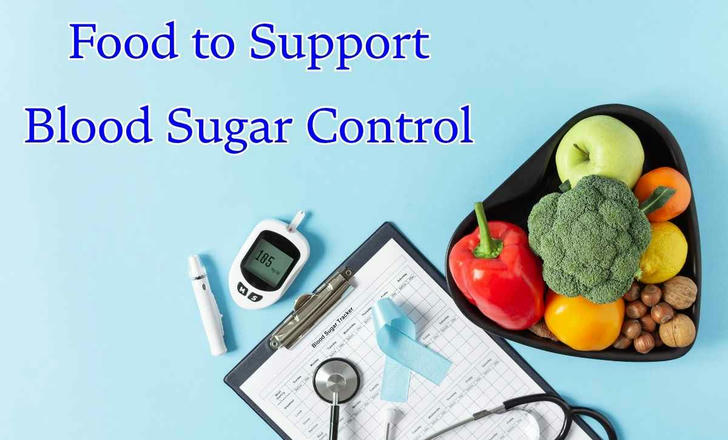5 Foods That May Help Lower Blood Sugar Quickly
Diabetes can be managed with the diet, monitoring, and appropriate treatment, helping you maintain a good quality of life.
1. 5 Foods That Lower Blood Sugar Quickly
Certain foods have been studied for their potential to help lower blood sugar levels in the short term. These may support blood glucose control when incorporated into a balanced diet:
🔶 Bitter Melon
Contains plant-based compounds that mimic insulin activity, potentially aiding blood sugar regulation.
🔶 Chia Seeds
Rich in fiber, chia seeds can slow digestion and help maintain more stable blood sugar levels after meals.
🔶 Apple Cider Vinegar (Diluted)
Diluted apple cider vinegar consumed before meals may reduce post-meal blood sugar spikes.
🔶 Legumes (e.g., Chickpeas)
Low glycemic index and high protein content make legumes a good option for blood sugar management.
🔶 Steel-Cut Oats (Unsweetened)
A source of complex carbohydrates and fiber, steel-cut oats may contribute to slower glucose absorption.
Implementation tips:
• Include these foods regularly in meals rather than relying on them sporadically.
• Combine with lean proteins and healthy fats for balanced nutrition.
• Monitor blood sugar response individually, as effects can vary.

2. Diet to Support Blood Sugar Control and Short-Term Improvements
A carefully planned diet plays a central role in managing blood sugar levels and may contribute to improvements over weeks:
• Moderate Carbohydrate Intake
Emphasizing quality carbohydrates such as whole grains and legumes rather than extreme carbohydrate restriction.
• Increase Dietary Fiber
Vegetables, nuts, and seeds provide fiber that supports glucose regulation.
• Limit Refined Sugars and High Glycemic Foods
Reducing foods that cause rapid blood sugar spikes helps maintain more consistent levels.
• Calorie Control and Weight Management
Monitoring total calorie intake supports body weight goals, which can influence insulin sensitivity.
Step-by-step suggestions:
Plan meals with a balance of protein, fiber, and healthy fats.
Use portion control methods such as measuring cups or food scales.
Prepare meals at home to better control ingredients and avoid added sugars.
Track food intake and blood sugar responses to understand personal effects.
Initial improvements in blood sugar may be seen within 30 days, but this is part of ongoing management rather than full remission.
3. Can Type 2 Diabetes Be Reversed?
The term "reversal" of type 2 diabetes is often misunderstood. In scientific terms, remission means blood sugar levels stay within the normal range without the use of medication. This can sometimes be achieved through ongoing lifestyle changes such as diet, weight loss, and exercise.
However, remission is not possible for everyone and depends on individual factors. Continuous management and monitoring remain important regardless of remission status.
4. Monitoring Guidelines for Type 2 Diabetes
Regular monitoring of blood sugar is essential to understand the condition and guide treatment:
• Frequency of Testing
Monitoring fasting blood sugar and postprandial (after meals) levels provides useful information on glucose control.
• HbA1c Testing
Measures average blood sugar over 2-3 months and is recommended every 3 to 6 months depending on individual circumstances.
• Tools for Monitoring
Blood glucose meters and continuous glucose monitoring (CGM) systems can assist in tracking levels.
• Record Keeping
Maintaining a blood sugar log and sharing it with healthcare providers helps optimize treatment plans.
5. Importance of Water Intake in Blood Sugar Management
Proper hydration supports kidney function, which plays a role in eliminating excess sugar from the body:
• Drinking plain water or unsweetened beverages helps avoid added sugars that increase blood glucose.
• Staying well-hydrated may assist in overall metabolic health.
• Caution is advised regarding marketed “functional waters” or “detox drinks” claiming to reduce blood sugar, as these are not substitutes for medical treatment.
6. New Medications for Type 2 Diabetes
Advances in medication offer additional options to support blood sugar control:
• GLP-1 Receptor Agonists
Medications such as semaglutide can improve glucose control and assist with weight management.
• SGLT2 Inhibitors
These drugs help remove glucose through urine and may provide cardiovascular benefits.
Medication should only be taken under medical supervision. Self-medication or unapproved use is discouraged.
Conclusion
Managing type 2 diabetes is a long-term process that involves balanced diet, regular monitoring, and appropriate medical treatment. Combining these elements under professional guidance can help improve quality of life.
Every change should be carefully evaluated to suit individual health needs.
